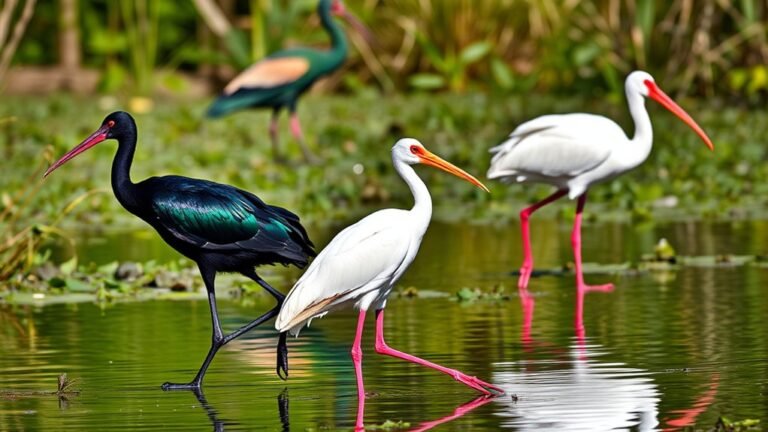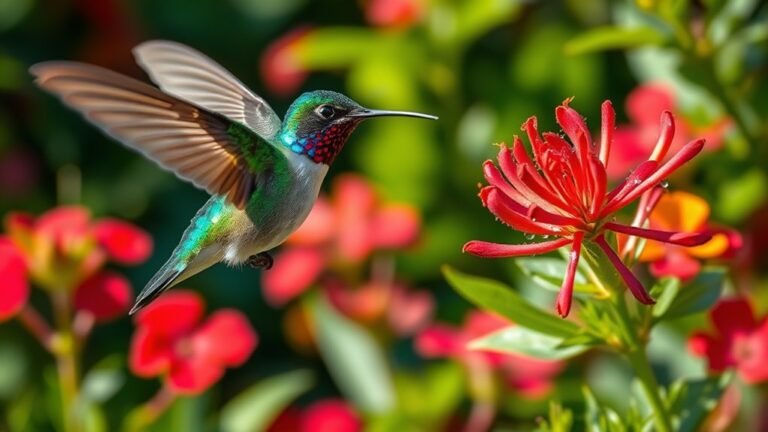8 Blue Birds With Orange Chests: Quick Guide
When you see blue birds with bright orange chests, think about their roles in nature. Birds like the Eastern Bluebird and Blue Grosbeak showcase vibrant colors and interesting behaviors that help them thrive in their environments. Each species has unique traits that aid in survival and support the ecosystems they live in. Appreciating these birds can reveal more than just their beauty; it highlights their importance in nature.
Key Takeaways
- The Eastern Bluebird has bright blue feathers and an orange chest. It thrives in open fields and gardens.
- The Blue Grosbeak features rich blue plumage with an orange-brown chest. It prefers shrubby areas and is known for its beautiful songs.
- Lazuli Buntings have a striking blue head and a warm orange chest. They enjoy open fields and sing melodious tunes during breeding.
- Indigo Buntings are small birds that are bright blue with some variations showing orange motifs. They are found in deciduous forests and open spaces.
- Blue Jays display vibrant blue feathers and a distinct crest. They are commonly seen in wooded areas and parks and display complex social behaviors.
Explore these beautiful blue birds and enjoy their unique characteristics!
Eastern Bluebird

The Eastern Bluebird is a beautiful bird with bright blue feathers and a warm orange chest. These birds thrive in open fields, gardens, and areas with some trees. They prefer places that offer plenty of insects and berries for their diet.
When observing Eastern Bluebirds, watch their nesting behavior. They like to nest in tree holes and man-made boxes, using soft materials to make a comfortable space for their young.
During breeding season, male Eastern Bluebirds become more colorful to attract females.
This species shows the beauty of nature and emphasizes the need for proper habitats for their survival and reproduction. Connecting with these birds can deepen your appreciation for the wildlife around you.
Blue Grosbeak
Blue Grosbeaks stand out among blue birds with their rich blue colors and orange-brown chest. They prefer shrubby areas, roadsides, and open woodlands filled with dense plants.
These birds sing beautiful songs and have interesting social behaviors. During breeding season, male Blue Grosbeaks defend their territory through impressive flight displays.
They mainly eat seeds and insects, showing their ability to thrive in various environments. By observing Blue Grosbeaks, you can gain a deeper appreciation for their role in nature and enjoy the beauty of our diverse wildlife.
Lazuli Bunting

The Lazuli Bunting is a striking bird found in open woodlands and grasslands. Its head and back are a bright blue, while its chest is a warm orange. This bird lives in semi-arid areas and displays interesting behaviors.
Here are important facts about the Lazuli Bunting:
- Habitat: It prefers open fields, woodland edges, and riverbanks.
- Behavior: In breeding season, it sings a beautiful melody.
- Diet: Its diet consists mainly of seeds and insects.
- Migration: The Lazuli Bunting migrates long distances between its breeding and wintering grounds.
This bird enchants birdwatchers with its vivid colors and sweet song.
Indigo Bunting
The Indigo Bunting is a small bird known for its bright blue color. It mainly lives in North America and prefers habitats like deciduous forests, shrubby areas, and open spaces.
During spring, male Indigo Buntings perform courtship displays. They sing beautiful songs to attract females. Their diet consists of seeds and insects, showing they can adapt to different environments.
You can often see them perched on low branches or foraging on the ground. Learning about the Indigo Bunting's behavior and habitat helps you appreciate this lovely bird.
As you watch them, you'll connect with the beauty of nature around you.
Blue Jay

The Blue Jay is a vibrant bird known for its striking blue feathers and distinctive crest. You can often find them in wooded areas, parks, and gardens. Their ability to adapt to different environments is impressive.
Here is more about Blue Jays:
- Social Structure: Blue Jays have complex social behaviors, often interacting with each other in interesting ways.
- Vocalizations: They produce a variety of calls. These sounds can signal danger or attract a mate, showcasing their communication skills.
- Dietary Preferences: As omnivores, Blue Jays eat insects, nuts, and fruits. This variety in their diet shows their ability to find food in different settings.
- Nest Locations: Blue Jays build their nests in dense tree branches. This choice helps protect their young from potential threats.
Watching Blue Jays can be a delightful experience. Their bright colors and lively behaviors make them a favorite among birdwatchers.
Whether you see them in a park or your backyard, Blue Jays add beauty and energy to the environment.
Barn Swallow
Barn Swallows are fascinating birds known for their slim bodies and unique forked tails.
They're skilled builders, creating mud nests under eaves or bridges. These nests are made strong with saliva, showcasing their impressive craftsmanship.
Barn Swallows migrate thousands of miles. They breed in North America and travel to South America for the winter.
Connecting with other birdwatchers allows you to share stories about their migrations and nesting habits, building a sense of community.
Enjoy the beauty that Barn Swallows add to our skies.
Tree Swallow
Tree Swallows are known for their bright blue-green feathers and white undersides. They display interesting behaviors that highlight their social lives.
Here's what you can observe:
- Foraging: They catch insects while flying, showing impressive aerial skills.
- Nesting: Tree Swallows often choose old tree cavities or man-made structures to nest in.
- Social Bonds: These birds form strong groups and often nest in colonies.
- Migration: Tree Swallows migrate thousands of miles between their breeding and winter homes, demonstrating their endurance.
Learning about Tree Swallow behaviors can enhance your appreciation for their role in nature and their ability to adapt.
This knowledge connects bird watchers and nature lovers, fostering a deeper understanding of these fascinating birds.
Azure-Winged Magpie
Azure-Winged Magpies have striking blue wings and unique black-and-white faces. They're social and intelligent birds, which makes them interesting to bird watchers.
These magpies live in open woodlands and scrublands in southern and eastern Europe, especially in Spain and Portugal. Their habitats of scattered trees and bushes help them find food.
Azure-Winged Magpies often form small groups. They communicate with various sounds. This teamwork helps them when they search for food and when they escape predators.
Their problem-solving abilities and tool use show their high intelligence. Understanding these behaviors can help you appreciate the social lives of these captivating birds.
Frequently Asked Questions
What Is the Diet of Blue Birds With Orange Chests?
Blue birds with orange chests eat a variety of foods. They like insects such as beetles and caterpillars. They also enjoy berries, specifically elderberries and mulberries. This diverse diet helps them survive in different environments.
Where Can I Find These Birds in North America?
To find these birds in North America, look in open woodlands and shrublands. They like to nest in dense foliage. By knowing where they prefer to live, you can spot them more easily during their breeding season. Enjoy the experience of watching these birds in their natural habitat!
Are Blue Birds With Orange Chests Migratory?
Blue birds with orange chests are migratory. They migrate south for the winter in search of warmer weather. This migration helps them survive and improves their chances of successful breeding in the spring. Their movement from colder regions to milder climates is a key part of their life cycle.
How Can I Attract Them to My Garden?
To attract bluebirds with orange chests to your garden, set up bird feeders. Fill them with high-quality seed mixes. Plant a variety of flowers, shrubs, and trees that provide food, shelter, and nesting sites. This will make your garden more inviting for these beautiful birds. Enjoy observing their vibrant colors and cheerful songs as they visit your space!
What Threats Do These Birds Face in the Wild?
These birds face serious threats in the wild. Habitat loss decreases their places to nest. Larger animals pose predation risks that make survival difficult. You can help by protecting their habitats and spreading awareness about their challenges.

Kashvi is a passionate bird enthusiast and nature lover who has been fascinated by the world of birds for years. With a keen eye for detail and a love for learning, Kashvi is dedicated to sharing her knowledge and insights with fellow bird enthusiasts on Avian Enthusiasts. Through her engaging and informative articles, Kashvi aims to inspire others to join her in exploring the fascinating world of birds and to promote a deeper appreciation for these incredible creatures.







